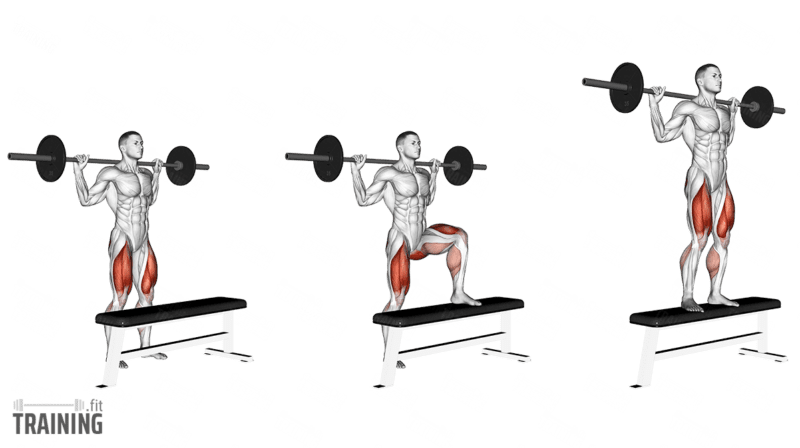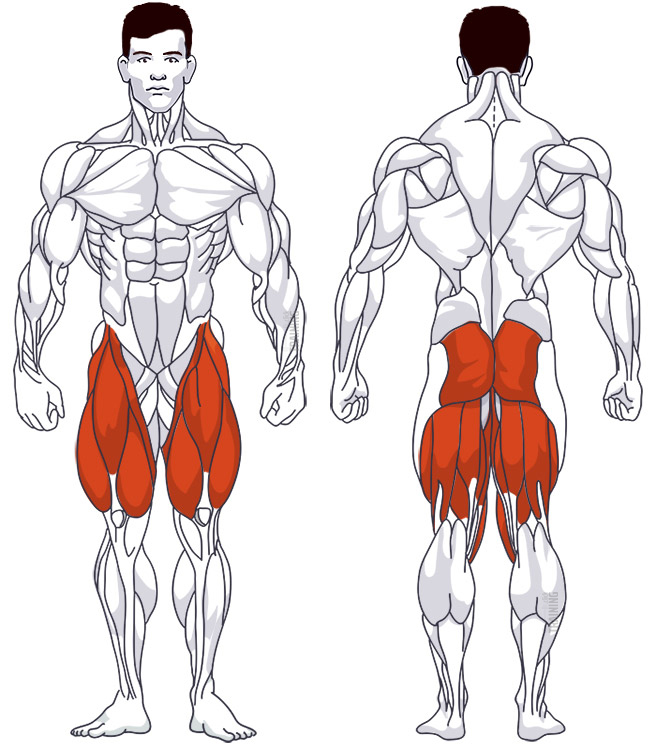Barbell Step-Ups
Compound exercise, Free weightsOverview

Main muscles
- Thigh: Quadriceps
(Musculus quadriceps femoris) - Thigh: Thigh flexor
(Musculus biceps femoris) - Buttocks: Large gluteus maximus
(Musculus gluteus maximus)
Training plans
Barbell Step-Ups is a suitable substitute for similar exercises in or as a supplement to various training plans.
Barbell Step-Ups: Basics and alternatives

Involved main muscle groups:
Barbell Step-Ups
Barbell step-ups are just one way to perform this exercise, and you can also do step-ups without equipment or with dumbbells. All versions of this exercise are fantastic for working your entire leg muscles, particularly the thighs and butt. As the name suggests, you’ll be stepping up onto a stable surface while carrying a barbell.
You can also try sideways step-ups to better target your inner thigh muscles.
Correct execution
You’ll need a stable surface and a barbell for this exercise. A flat bench is typically suitable, especially if you’re using heavy weights. Alternatively, you can use dedicated stairs or boxes designed for barbell step-ups, as they can usually handle a high weight load.
The height of the platform should be just below your knee, but there isn’t a strict rule for this. A lower step will make the exercise easier, while a higher one will make it more challenging and less stable. Choose a height that allows you to maintain safe stability.
Video tutorial
Step-by-step instructions
Stand hip-width apart in front of the bench or box. Hold the barbell behind your neck, gripping it firmly with both hands. If it’s uncomfortable, you can wrap a towel around it or use a barbell neck pad.
Position your training leg on the bench without stepping up. Keep your abs tight and your back straight in this starting position.
Begin the step-up by stepping onto the bench or box. Use only your training leg to lift yourself up, and don’t push off the ground with your second leg. Keep the barbell behind your neck with the same grip throughout.
Use your second leg only for stabilization at the top of the step, not for relieving tension in the training leg. Lightly touch the bench or box with the toe or sole of your second leg.
Reverse the movement, touching the ground with your second leg and allowing it to take a bit of weight off your training leg. Maintain muscle tension in the training leg.
After completing the reps with one leg, switch to the other leg and do the same number of reps.
Alternative execution
You can also alternate legs during barbell step-ups.
Follow the instructions above through point 4, then firmly plant both feet on the ground instead of only slightly unloading the training leg as described in point 5. Start the next rep with your second leg as the training leg.
This alternating method promotes a more balanced performance.
Common mistakes and injuries
The force for stepping up should come solely from your training leg. Don’t use your second leg to push off the ground, as it greatly reduces the training effect. If needed, lower the weight to maintain proper form and reduce injury risk.
Speaking of injury risk, carrying a barbell on your back while stepping up and down can increase the risk of ankle injuries. Pay close attention to each step to avoid accidents. If your ankle bends while stepping up, it can not only cause immediate pain but also lead to longer injury-related training downtime, depending on the weight you’re using. So, always perform each step consciously and attentively to minimize the risk of injury.